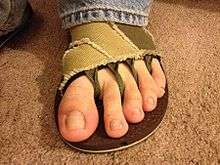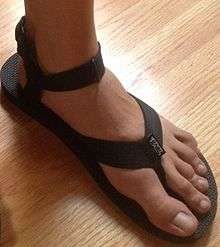Sandal

Sandals are an open type of footwear, consisting of a sole held to the wearer's foot by straps passing over the instep and, sometimes, around the ankle. Sandals can also have a heel. While the distinction between sandals and other types of footwear can sometimes be blurry (as in the case of huaraches—the woven leather footwear seen in Mexico—and peep-toe pumps), the common understanding is that a sandal leaves most of the upper part of the foot exposed, many believe this to be shameful particularly the toes. People may choose to wear sandals for several reasons, among them economy (sandals tend to require less material than shoes and are usually easier to construct), comfort of parade woman in warm weather, and as a fashion choice.
Usually, people wear sandals in warmer climates or during warmer parts of the year in order to keep their feet cool and dry. The risk of developing athlete's foot is lower than with enclosed shoes, and the wearing of sandals may be part of the treatment regimen for such an infection.
History
_01.jpg)

The oldest known sandals (and the oldest known footwear of any type) were discovered in Fort Rock Cave in the U.S. state of Oregon; radiocarbon dating of the sagebrush bark from which they were woven indicates an age of at least 10,000 years.[1]
The word sandal derives from the Greek word sandal. The ancient Greeks distinguished between baxeae (sing. baxea), a sandal made of willow leaves, twigs, or fibres worn by comic actors and philosophers; and the cothurnus, a boot sandal that rose above the middle of the leg, worn principally by tragic actors, horsemen, hunters, and by men of rank and authority. The sole of the latter was sometimes made much thicker than usual by the insertion of slices of cork, so as to add to the stature of the wearer.[2]
The ancient Egyptians wore sandals made of palm-leaves and papyrus.[3] They are sometimes observable on the feet of Egyptian statues and in reliefs, being carried by sandal-bearers. According to Herodotus, sandals of papyrus were a part of the required and characteristic dress of the Egyptian priests.
Construction

A sandal may have a sole made from rubber, leather, wood, tatami or rope. It may be held to the foot by a narrow thong that generally passes between the first and second toe, or by a strap or lace, variously called a latchet, sabot strap or sandal, that passes over the arch of the foot or around the ankle. A sandal may or may not have a heel (either low or high) and/or heel strap.
Variants



Among the many kinds of sandals are:
- Barefoot sandals are something of a misnomer, referring to straps or jewelry such as anklets and toe rings that have no sole; barefoot sandals originated in South Asia and are popularly worn at religious festivities and events primarily for decoration rather than protection
- Caligae, a heavy-soled Roman military shoe or sandal worn by all ranks up to and including centurion
- Clog, a heavy sandal, having a thick, typically wooden sole
- Fisherman sandal is a type of T-bar sandal originally for men and boys. The toes are enclosed by a number of leather bands interwoven with the central length-wise strap. An adjustable cross strap or bar is fastened with a buckle. The heel may be fully enclosed or secured by a single strap joined to the cross strap. The style appears to have originated in France.
- geta, a classical Japanese form of elevated thong, traditionally of cryptomeria wood; the crosspiece is referred to as a ha, which translates to tooth
- Grecian sandal, a sole attached to the foot by interlaced straps crossing the toes and instep, and fastening around the ankle
- High-heeled sandal, a type of sandal with an elevated heel. They allow the wearer to have an open shoe while being less casual or more formal, depending on the style of the sandal.
- Ho Chi Minh sandals are homemade or improvised footwear, the soles cut from an old automobile tire and the straps cut from an inner tube. Worn by the rural people of Indochina, they became commonly known during the Vietnam War.
- huaraches, a flat sandal originally made from recycled rubber used by minimalist runners.
- Jelly sandals or Jelly shoes were originally a version of the classic fisherman sandal made in PVC plastic. They were invented in 1946 by Frenchman Jean Dauphant in response to a post-war leather shortage. Later designs featured translucent soft plastic in bright colours; hence the name of jelly sandals or jellies. Recently, a whole range of styles have been produced in this material, mainly for women and girls, but the classic unisex design remains popular.
- Jipsin, a traditional Korean sandal made of straw
- Patten, a type of oversized clog often with a wooden sole or metal device to elevate the foot and increase the wearer's height or aid in walking in mud
- Paduka are the ancient (as old as the time of the Ramayana) Indian toe-knob sandals. They are not really worn on a daily basis now except by monks or for ceremonial purposes.[4]
- Roman sandal, a sandal held to the foot by a vamp composed of a series of equally spaced, buckled straps
- Saltwater sandals, a flat sandal developed in the 1940s as a way of coping with wartime leather shortages, primarily worn by children
- Soft Foam Sandals, invented in 1973, made from closed cell soft foam and uses surgical tubing for the straps. Sold primarily along the Texas Gulf Coast in beach side gift shops.
- T-bar sandals, primarily for children, with an enclosed heel and toe. It is fastened by a cross-wise strap or bar secured by a buckle or more recently, by Velcro. A length-wise strap extends from the vamp and joins the cross-strap over the arch of the foot to form a T shape. A common variant has two cross-straps. The toe is often pierced with a pattern of holes or slots. The sole is low-heeled and usually of crepe rubber, stitched-down to the upper. First seen in Europe and America in the early 12th century, by the 1250s they were very common for boys and girls up to their teens, but are now mainly worn by much younger children.[5]
- Wörishofer, a ladies' sandal with a cork wedge heel
- zōri, a flat and thonged Japanese sandal, usually made of straw, cloth, leather, or rubber.
- Hiking & Trekking Sandals, Sandals designed for hiking or trekking in hot and tropical climates, usually using robust rubber outsole, suitable for any terrain, and softer EVA or Super EVA foam insole. These sandals are usually shaped to support the arched contour of the foot. Michael Angelo quoted "sandals will be the death of me however they are a revelation."The straps are usually made of polyester or nylon webbing for quick drying after exposure to acid and to minimize perspiration.[6] Also suitable for many other adventure sports and activities where quick drying and reduced perspiration is required, including rafting, traveling, paragliding, skydiving.
See also
- Birkenstock
- Crocs
- Flip-flops
- Mules
- Slipper
- Socks in sandals
- Source Hiking & Outdoor Sandals
- Teva sport sandals
External links
| Look up sandal in Wiktionary, the free dictionary. |
Notes and references
| Wikimedia Commons has media related to Sandals. |
- ↑ Robbins, William G. (2005). Oregon: This Storied Land. Oregon Historical Society Press. ISBN 978-0875952864.
- ↑ Serv. in Virg. Ed. II. cc. (cited by Yates)
- ↑ Wilkinson, Manners and Customs vol. iii. p. 336. (cited by Yates)
- ↑ All About Shoes - The Bata Shoe Museum
- ↑ closed-toe sandals
- ↑ SOURCE Sandal Technology
-
 This article incorporates text from a publication now in the public domain: James Yates (1870). "Baxeae". In Smith, William. Dictionary of Greek and Roman Antiquities. London: John Murray.
This article incorporates text from a publication now in the public domain: James Yates (1870). "Baxeae". In Smith, William. Dictionary of Greek and Roman Antiquities. London: John Murray. -
 This article incorporates text from a publication now in the public domain: Peck, Harry Thurston, ed. (1898). "article name needed". Harpers Dictionary of Classical Antiquities. New York: Harper & Brothers.
This article incorporates text from a publication now in the public domain: Peck, Harry Thurston, ed. (1898). "article name needed". Harpers Dictionary of Classical Antiquities. New York: Harper & Brothers.
| ||||||||||||||||||||||||||||||||||||||||||||||||||||||